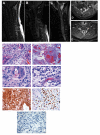Pediatric primary intramedullary spinal cord glioblastoma
- PMID: 21139963
- PMCID: PMC2994522
- DOI: 10.4081/rt.2010.e48
Pediatric primary intramedullary spinal cord glioblastoma
Abstract
Spinal cord tumors in pediatric patients are rare, representing less than 1% of all central nervous system tumors. Two cases of pediatric primary intramedullary spinal cord glioblastoma at ages 14 and 8 years are reported. Both patients presented with rapid onset paraparesis and quadraparesis. Magnetic resonance imaging in both showed heterogeneously enhancing solitary mass lesions localized to lower cervical and upper thoracic spinal cord parenchyma. Histopathologic diagnosis was glioblastoma. Case #1 had a small cell component (primitive neuroectodermal tumor-like areas), higher Ki67, and p53 labeling indices, and a relatively stable karyotype with only minimal single copy losses involving regions: Chr8;pter-30480019, Chr16;pter-29754532, Chr16;56160245-88668979, and Chr19;32848902-qter on retrospective comparative genomic hybridization using formalin-fixed, paraffin-embedded samples. Case #2 had relatively bland histomorphology and negligible p53 immunoreactivity. Both underwent multimodal therapy including gross total resection, postoperative radiation and chemotherapy. However, there was no significant improvement in neurological deficits, and overall survival in both cases was 14 months.This report highlights the broad histological spectrum and poor overall survival despite multi modality therapy. The finding of relatively unique genotypic abnormalities resembling pediatric embryonal tumors in one case may highlight the value of genome-wide profiling in development of effective therapy. The differences in management with intracranial and low-grade spinal cord gliomas and current management issues are discussed.
Keywords: glioblastoma; intramedullary; pediatric; spinal cord.
Figures


References
-
- Epstein FJ. Philadelphia: W.B. Saunders; 1994. Pediatric Neurosurgery.
-
- Helseth A, Mørk SJ. Primary intraspinal neoplasms in Norway, 1955 to 1986. A population-based survey of 467 patients. J Neurosurg. 1989;71:842–5. - PubMed
-
- Merchant TE, Nguyen D, Thompson SJ, et al. High-grade pediatric spinal cord tumors. Pediatr Neurosurg. 1999;30:1–5. - PubMed
-
- Minehan KJ, Brown PD, Scheithauer BW, et al. Prognosis and treatment of spinal cord astrocytoma. Int J Radiat Oncol Biol Phys. 2009;73:727–33. - PubMed
Publication types
Grants and funding
LinkOut - more resources
Full Text Sources
Research Materials
Miscellaneous

